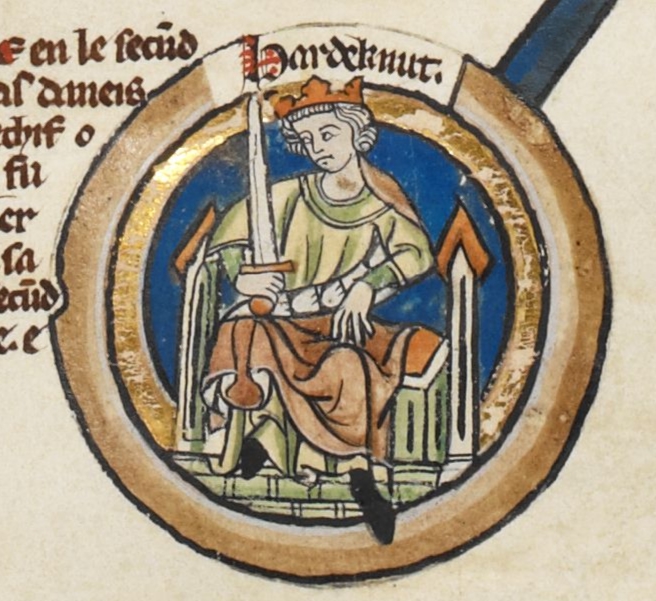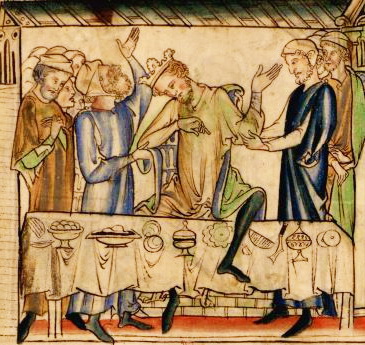by Susan Flantzer © Unofficial Royalty 2019

Harthacnut, King of Denmark and England; Credit – Wikipedia
The last of the House of Denmark to reign in England, Harthacnut was the elder of the two children and the only son of Cnut the Great, King of England, Denmark, and Norway and his second wife Emma of Normandy, daughter of Richard I, Duke of Normandy. Harthacnut was born in England around 1018.
After Cnut’s conquest of England in 1016, he had put aside his first wife Ælfgifu of Northampton and married Emma of Normandy, the widow of Æthelred II the Unready, King of the English. At that time, it was acceptable to put aside one wife and take another. Cnut succeeded his brother Harald II as King of Denmark in 1019. In 1029, Cnut invaded Norway and when King Olaf II of Norway was killed in 1030 at the Battle of Stiklestad, Cnut became King of Norway. He also ruled parts of Sweden, Pomerania, and Schleswig. Cnut’s dominions were known as the North Sea Empire.

The North Sea Empire of Cnut the Great; Credit – By Hel-hama – Own work, CC BY-SA 3.0, https://commons.wikimedia.org/w/index.php?curid=19863973
Harthacnut had one younger sibling:
- Gunhilda of Denmark (circa 1020 – 1038), married Heinrich III, Holy Roman Emperor, had one daughter
Harthacnut had two half-siblings from his father’s first marriage to Ælfgifu of Northampton:
- Sweyn Cnutsson (circa 1016–1035), unmarried
- Harold Harefoot, King of England (circa 1016 – 1040), unmarried (?)

Harthacnut’s mother Emma of Normandy, with her two sons by Æthelred II; Credit – Wikipedia
Harthacnut had three half-siblings from the first marriage of his mother Emma of Normandy to Æthelred II, King of the English:
- Saint Edward the Confessor, King of England (circa 1003 – 1066), married Edith of Wessex, no children
- Goda of England (1004 – circa 1047), married (1) Drogo of Mantes, Count of the Véxin, had three children (2) Eustace II, Count of Boulogne, no children
- Alfred Ætheling (circa 1005 – 1036), unmarried
Harthacnut was first mentioned in the Anglo-Saxon Chronicle when he and his mother attended the transfer of the remains of Ælfheah, Archbishop of Canterbury from London to Canterbury in June 1023. In 1028, at the age of ten, Harthacnut accompanied his father to Denmark. Cnut left his son there as his deputy and he was still in Denmark when Cnut died on November 12, 1035.

Cnut, King of England, Denmark, and Norway, and his sons Harold Harefoot and Harthacnut; Credit – Wikipedia
Cnut had decreed that any sons of his second marriage should take precedence over the sons of his first marriage. This meant that Cnut and Emma’s only son Harthacnut was the legitimate heir to England and Denmark. As Harthacnut was in Denmark, he easily succeeded his father as King of Denmark. However, he was unable to come to England because Denmark was under threat of invasion by Norway and Sweden. Because of this, the council elected Cnut’s son by his first wife Harold Harefoot Regent of England as a temporary measure. Harold Harefoot, almost immediately, requested that he be proclaimed King of England but Æthelnoth, Archbishop of Canterbury, refused to do so.
In 1037, with the support of Leofric, Earl of Mercia and other nobles, Harold Harefoot was proclaimed King of England and crowned in Oxford. One of his first acts was to banish his stepmother Emma, who went into exile in Bruges, then in Flanders, now in Belgium. Harold Harefoot had a short reign, dying in Oxford, England on March 17, 1040, aged about 24-years-old.
On June 14, 1040, Harthacnut arrived at Sandwich, England with sixty-two warships and ascended the English throne unchallenged. He had Harald Harefoot’s body exhumed, decapitated, and thrown into a swamp but then it was retrieved and thrown in the River Thames. Shortly afterward, Harold Harefoot’s body was pulled from the River Thames by a fisherman and was buried at St. Clement Danes Church in London.
Harthacnut was crowned at Canterbury Cathedral on June 18, 1040, by Eadsige, Archbishop of Canterbury. England was accustomed to the king ruling with a council but Harthacnut became more authoritarian. To enlarge and maintain his naval fleet, he severely increased the taxation rate. At the same time, the tax rate was increased, the harvest was poor and this caused hardship and dissatisfaction. The town of Worcester became the focal point of the tax resistance against Harthacnut. Two tax collectors were killed there in May 1041. A military force was sent to deal with the situation but the townspeople defended themselves by moving away from the town. However, Harthacnut’s army sacked and burned Worcester. The Anglo-Saxon Chronicle says about Harthacnut, “He never did anything worthy of a king while he reigned.”

Death of King Harthacnut at a wedding feast; Credit – Wikipedia
Harthacnut was unmarried and in 1041, he invited his half-brother Edward (the Confessor) home from his exile in Normandy and made him his heir. On June 8, 1042, Harthacnut attended a wedding in Lambeth, London, England. As he was drinking to celebrate the wedding, according to the Anglo-Saxon Chronicle, “He died while standing with his drink. Suddenly he fell to the ground with violent convulsions.” Harthacnut was only 23-24 years old. There were unproven suspicions that he was poisoned and certainly there were people who would have benefitted from his death. His death also could have been caused by a stroke due to excessive drinking. A 2015 study speculated that perhaps up to fourteen Danish kings, including Harthacnut, who suddenly died at a relatively young age without being ill, possibly died of Brugada Syndrome, a genetic disorder in which the electrical activity in the heart is abnormal. It increases the risk of abnormal heart rhythms and sudden cardiac death.
Harthacnut’s half-brother Edward the Confessor succeeded him as King of England. A political agreement Harthacnut had made with King Magnus I of Norway stated Magnus would succeed him as King of Denmark. Harthacnut was initially buried at the Old Minster in Winchester, England. When the Old Minster was demolished in 1093, Harthacnut’s remains were moved to Winchester Cathedral and were placed in a mortuary chest near the shrine of St. Swithun. However, his remains were ultimately interred in a tomb below the eastern arch of the cathedral in the north aisle. In 1525, Harthacnut’s tomb was remodeled and a plaque was placed on the tomb.
This article is the intellectual property of Unofficial Royalty and is NOT TO BE COPIED, EDITED, OR POSTED IN ANY FORM ON ANOTHER WEBSITE under any circumstances. It is permissible to use a link that directs to Unofficial Royalty.
England: House of Denmark Resources at Unofficial Royalty
- United Kingdom of Great Britain and Northern Ireland Index
- House of Denmark Index
- Coronations before the Norman Conquest (871 – 1066)
Works Cited
- Ashley, M. (1998). The Mammoth Book of British Kings & Queens. New York: Carroll & Graf Pub.
- Cannon, J. and Griffiths, R. (1988). The Oxford Illustrated History of the British Monarchy. Oxford: Oxford University Press.
- Dodson, A. (2004). The Royal Tombs of Great Britain. London: Duckworth.
- En.wikipedia.org. (2019). Harthacnut. [online] Available at: https://en.wikipedia.org/wiki/Harthacnut [Accessed 4 Mar. 2019].
- Flantzer, S. (2019). Cnut the Great, King of England, Denmark, and Norway. [online] Unofficial Royalty. Available at: https://www.unofficialroyalty.com/cnut-the-great-king-of-england-denmark-and-norway/ [Accessed 28 Feb. 2019].
- Flantzer, S. (2019). Emma of Normandy, Queen of England, Denmark, and Norway. [online] Unofficial Royalty. Available at: https://www.unofficialroyalty.com/emma-of-normandy-queen-of-england-denmark-and-norway/ [Accessed 28 Feb. 2019].
- Flantzer, S. (2019). Harold I Harefoot, King of England. [online] Unofficial Royalty. Available at: https://www.unofficialroyalty.com/harold-harefoot-or-harold-i-king-of-england/[Accessed 28 Feb. 2019]
- Williamson, D. (1998). Brewer’s British Royalty. London: Cassell.

